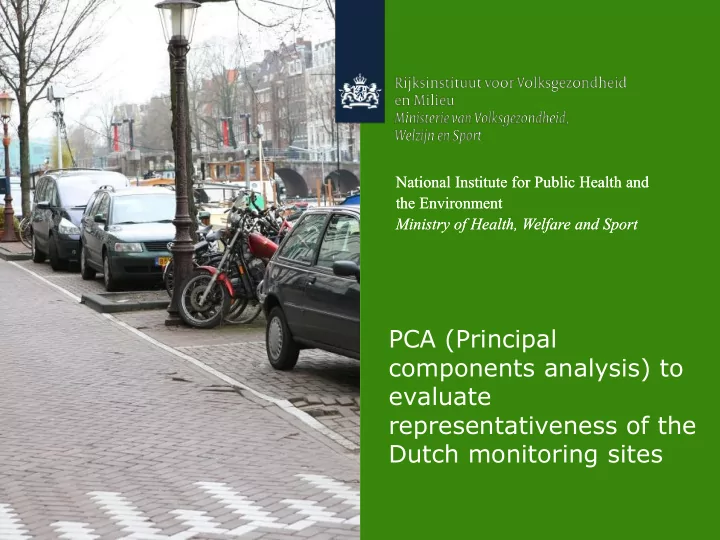

National Institute for Public Health and National Institute for Public Health and the Environment the Environment Ministry of Health, Welfare and Sport Ministry of Health, Welfare and Sport PCA (Principal components analysis) to evaluate representativeness of the Dutch monitoring sites
Contents ● Classification of measuring stations ● Use of Principal Components Analysis ● Concluding remarks 2 Fairmode meeting Oslo | april 28-29, 2014
Original work: Evaluation of the representativeness of the Dutch air quality monitoring stations The National, Amsterdam, Noord-Holland, Rijnmond-area, Limburg and Noord-Brabant networks, RIVM Report 680704021/2012 P.L. Nguyen, RIVM G. Stefess, RIVM D. de Jonge, GGD Amsterdam A. Snijder, DCMR P.M.J.A. Hermans, Province of Limburg S. van Loon, Province of Noord-Brabant R. Hoogerbrugge, RIVM 3 Fairmode meeting Oslo | april 28-29, 2014
Introduction ● There are several monitoring networks in the Netherlands: – National (National Institute for Public Health and the Environment) – Local environmental agencies – Large municipalities ● Stations in the Dutch Networks are classified in several types: – Rural – (Sub)Urban background – Traffic – Industry (not a formal classification) ● Quite similar to the classification used in Airbase. 4 Fairmode meeting Oslo | april 28-29, 2014
Introduction ● In many cases the type of station is clear. ● However, in some cases questions: – Outskirts of city (urban?) versus rural – Located near road (traffic?) with a limited amount of traffic – Urban location near industries – etc. ● Principal Components Analysis is one of the tools to help determine characteristics of measuring stations. ● Observed similar characteristics can be used to classify stations. 5 Fairmode meeting Oslo | april 28-29, 2014
Principal component analysis ● Principal component analysis (PCA) is a statistical procedure that uses orthogonal transformation to convert a set of observations of possibly correlated variables into a set of values of linearly uncorrelated variables called principal components. ● This transformation is defined in such a way that the first principal component has the largest possible variance (that is, accounts for as much of the variability in the data as possible), and each succeeding component in turn has the highest variance possible under the constraint that it is orthogonal to (i.e., uncorrelated with) the preceding components. Source: Wikipedia 6 Fairmode meeting Oslo | april 28-29, 2014
Principal component analysis Source: Wikipedia 7 Fairmode meeting Oslo | april 28-29, 2014
Diurnal variation (Concentration level) 8 Fairmode meeting Oslo | april 28-29, 2014
Diurnal variation (Concentration level) 9 Fairmode meeting Oslo | april 28-29, 2014
Diurnal variation (Concentration level) 10 Fairmode meeting Oslo | april 28-29, 2014
Street increment between paired stations: 9-22 g/m3 Diurnal variation (Concentration level) 11 Fairmode meeting Oslo | april 28-29, 2014
No significant treet increments or diurnal variations. Diurnal variation (Concentration level) 12 Fairmode meeting Oslo | april 28-29, 2014
Diurnal variation (Concentration level) 13 Fairmode meeting Oslo | april 28-29, 2014
PCA for NO2 and PM10 ● Diurnal variation and concentration for NO2 and PM10. ● Relatively clear groups of similar stations along the lines rural, urban, street. ● Several outliers. ● PM10 data doesn ’ t show distinct clusters of street and urban background or traffic stations. 14 Fairmode meeting Oslo | april 28-29, 2014
Concluding remarks ● Principal Components Analysis seems a valuable (additional) tool to find patterns in groups of monitoring stations and to classify the types. ● The RIVM would like to find out if other institutes also use PCA and what their results are. ● Please email: joost.wesseling@rivm.nl 15 Fairmode meeting Oslo | april 28-29, 2014
16 Fairmode meeting Oslo | april 28-29, 2014
Recommend
More recommend